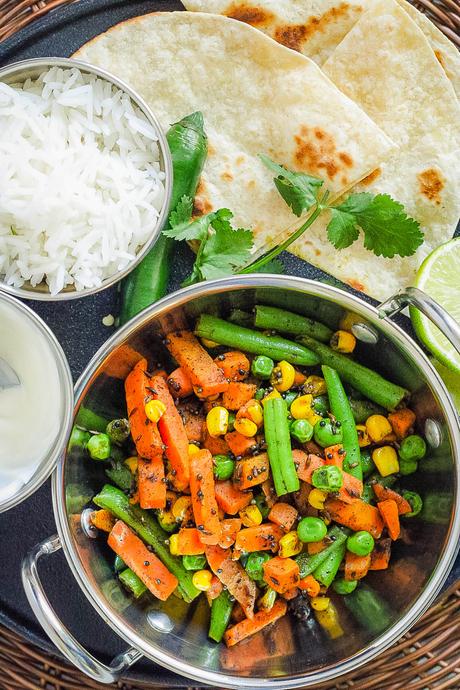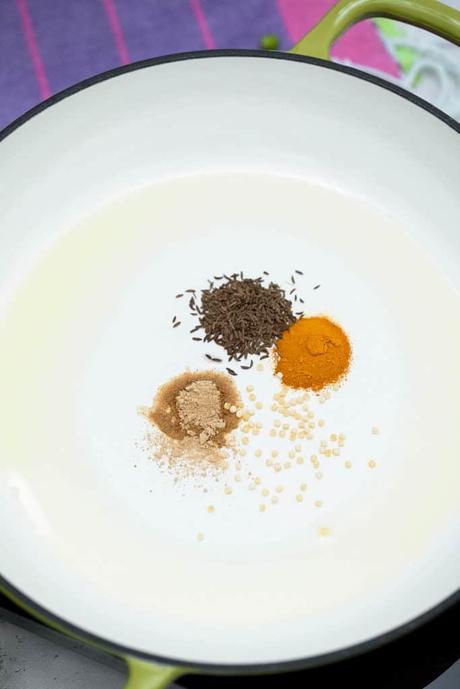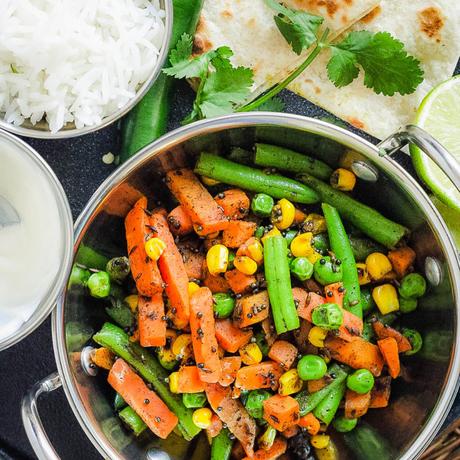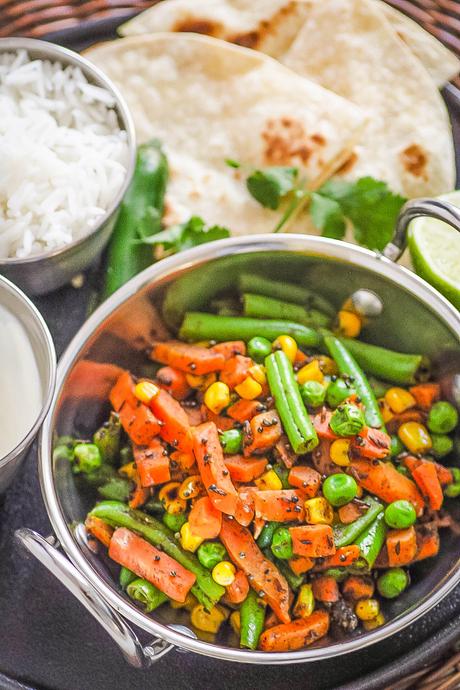This post may contain affiliate links. Please read my disclosure.
Indian Vegetables or Vegetable Sabji is best described as sautéd veggies with roasted Indian spices to amp up the flavor. It's a delicious side dish, or can be a main meal when served with roti, daal, or spiced yogurt for protein!
One of the things I love about my dad's cooking is it's classic homestyle Indian food made super easy (and healthy).
He and my mom both believed that you could create a great meal without having to spend hours and hours in the kitchen (which is a belief that clearly rubbed off on me).
One of my dad's specialities is this Indian Vegetables recipe. It's best described as sautéd veggies with roasted Indian spices that really amp up the flavor.
Latest Recipe Video!
I remember he used to make this delicious dish for me when we needed a quick and easy meal. He'd serve it with roti, a type of Indian bread, and a simple dal or even just spiced yogurt for protein and flavor.
This is a recipe that absolutely anyone can make.
It literally takes about 5 minutes of prep time and 10 minutes max of cooking time.
In that time, if you just heat up some roti and stir some curry powder, salt & cumin into some Greek Yogurt, you'll have a complete meal in 15 minutes. As you taste this vegetable sabji, it will instantly transport you to a homey kitchen in India.
What You'll Love About This Indian Vegetables Recipe...
- Quick and easy to prepare
- A simple side dish
- Make it a main meal by adding some healthy lean protein
- Super flavorful and perfectly spiced
- Authentic Indian flavors
Recipe Ingredients and Notes

Indian Spices: You'll need black mustard seeds, cumin seeds, asafetida, turmeric, and cayenne pepper. Using the seeds rather than ground spices helps to permeate the vegetables with the aroma and flavor of the spices. You can find these spices in most grocery stores, but you can also find them at a specialty spice shop, or Indian grocery store.
The spices above are basically the "base" of most Indian sabjis (vegetable curry type mixes). I keep them in a pretty traditional Indian Spice Tin that you can get at any Indian Grocery Store or even online.
Frozen Mixed Vegetables: This recipe is ultra easy to make because it uses frozen mixed vegetables. Rather than taking the time to chop all the veggies yourself, everything is ready to go! I recommend finding a mix with a bunch of different vegetables. I used one with green beans, peas, carrots, and corn. You can also add in some green leafy vegetables if you want more variety, or use whatever seasonal vegetables are available in your local grocery store!
Olive Oil: A touch of olive oil is all that's needed to sauté the spices and vegetables and create a truly flavorful dish! You can also use avocado oil or coconut oil if you prefer.
Tools and Equipment You'll Need
Step by Step Instructions
Temper Your Spices: Heat olive oil over medium-high heat in a large skillet - and add mustard & cumin seeds. Let them fry in the oil until they "pop" (you'll hear the popping/sizzling noise). Once they pop, add the hing, turmeric, cayenne (or green chili).

Cook The Veggies: Stir the spices, and then add the veggies. Stir the veggies until the spices are evenly incorporated. Let the veggies cook, continually stirring for about 10 minutes. Add salt to taste in the last minute or so of cooking.

Serve hot or at room temperature! Top with some diced cilantro, serve with whole wheat naan, roti, or rice.

Are Indian Vegetables Healthy?
Yes! This dish is super healthy and flavorful! The combination of vegetables and spices has vitamins and minerals, and lots of fiber!
- Rich in Essential Nutrients: Green beans, carrots, corn, and peas are an excellent source of nutrients. Peas have vitamin C and E, plus zinc, and antioxidants that help your immune system. Carrots are high in beta carotene, biotin, potassium, and vitamins A, and B6.
- Good Source of Protein: Peas are particularly high in plant-protein. When paired with coconut milk yogurt, and dal, this recipe is an excellent source of protein!
- High in Fiber: The combination of vegetables makes this side dish high in fiber. One serving has 6 grams of fiber. That's a quarter of the recommended daily fiber intake.
Recipe FAQs
What are the native vegetables in India?
Some of the native vegetables to India include cauliflower, cabbage, calabash, chili pepper, eggplant, garlic, lemon, okra, onion, potato, sweet potato, turnip, tomato, taro, fenugreek, coriander, and yams. Add some green vegetables to your sabji with some of these native vegetables to create a super flavorful and authentic dish.
What is the most popular vegetable in India?
Potatoes are the most popular vegetable in Indian cuisine. Root vegetables such as potatoes, or sweet potatoes, are used in a variety of dishes. It's a versatile vegetable that is used in curries and sabjis.
How do you serve these Indian spiced vegetables?
Serve with whole wheat roti, dal and/or spiced coconut milk yogurt for a complete meal. You can also serve with traditional basmati rice, or brown rice. Sprinkle with sesame seeds for added flavor and texture. If you think it needs a bit more spice, add a touch of black pepper.
How do you store and keep vegetable sabzi?
Allow the vegetables to cool completely. Transfer to an air tight container. Store in the refrigerator for 3-5 days. When ready to reheat warm in the microwave.
This recipe will also keep in the freezer for up to 2 months! To defrost, thaw in the fridge overnight, then heat in a pot over medium-low heat, or in the microwave for 1-2 minutes before serving.
Top Tips for Making Indian Vegetables
- Make sure to temper your spices before adding your vegetables - this will allow them to fully "bloom" and become aromatic, giving your veggies the best flavor possible!
- If you prefer, use fresh vegetables. They will require slightly more cooking time.
- A great way to make this recipe your own is to add a mix of vegetables you like best! Leafy greens, red onion, French beans are all excellent additions.


